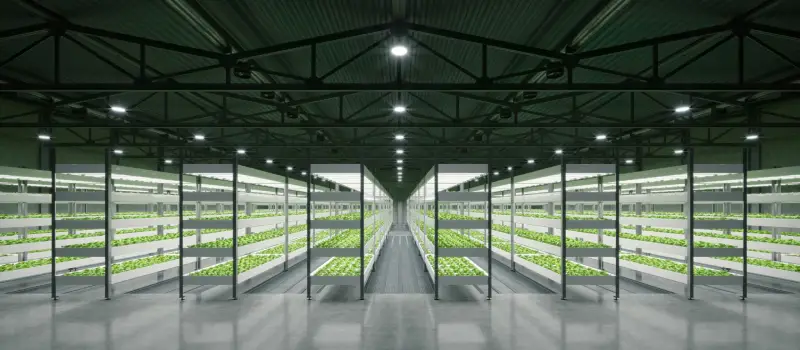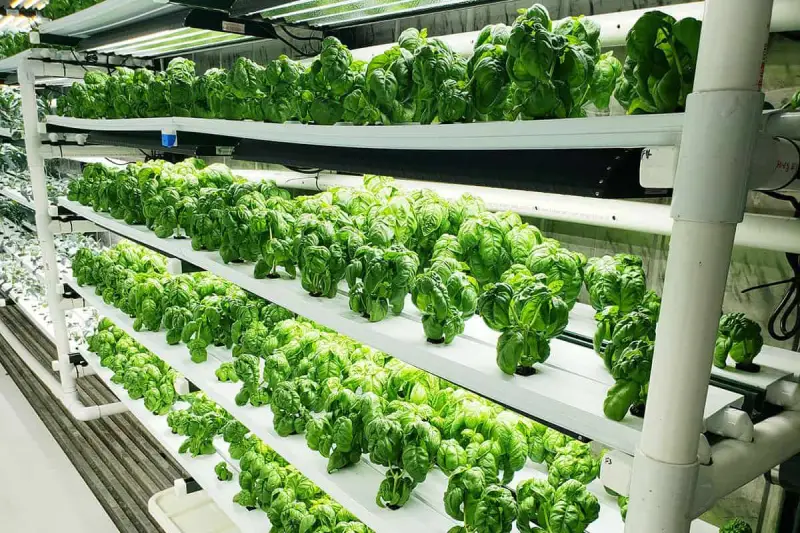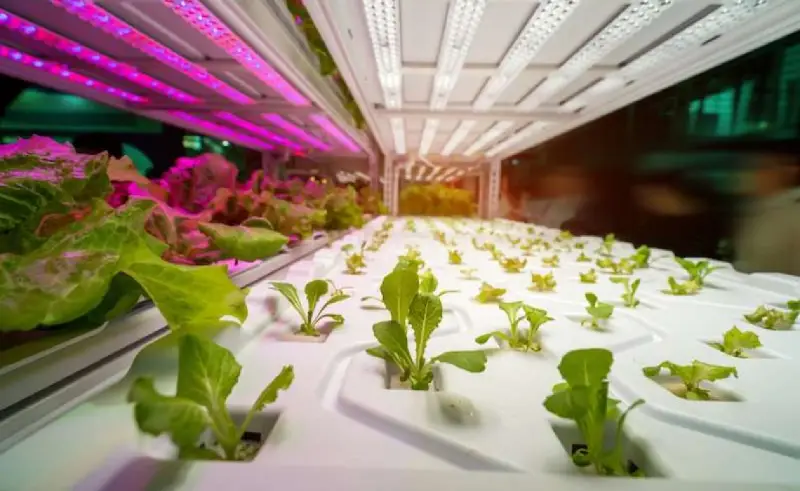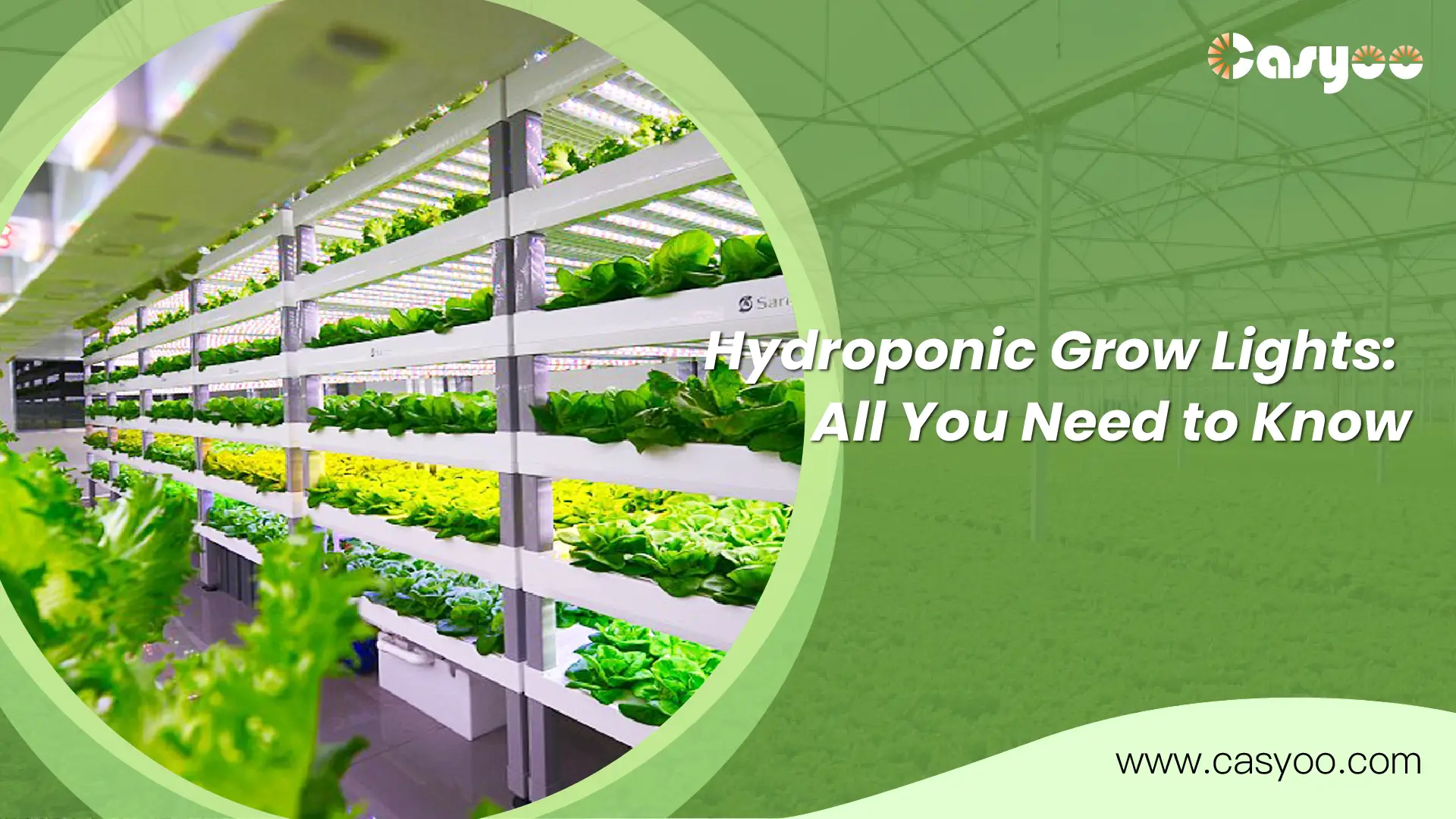Hydroponic lighting plays an integral role in growing sustainable crops on vertical farms. If you’re new to hydroponic lighting, you’ve come to the right place. We’ll discuss hydroponic grow lights in detail and tell you how to choose the right one.
Do you need hydroponic grow lights?
Most outdoor plants need up to eight hours of direct sunlight per day. While being out in the sun is ideal, if you’re growing them indoors, that’s usually not enough. You need a hydroponic grow light to provide enough light to support your growing needs. The great thing about hydroponic lights is that you can customize them to meet the specific needs of your indoor crops. This is different from natural light, which you can’t control.
How do hydroponic grow lights differ from regular lights?
Regular light bulbs can’t mimic the natural sunlight. Hydroponic lights emit a variety of wavelengths, which is more in line with the activity of the sun—sometimes it’s extremely bright, and sometimes it’s partially obscured by clouds. The fact that grow lights don’t get hot to the touch sets them apart from standard light bulbs. Too much heat can cause burning or even plant death.
What do a hydroponic lighting system consist of?

A hydroponic lighting system consists of four parts: a bulb, a remote ballast, a reflector, and a timer.
Light Bulbs
While almost any type of bulb can be used to grow plants, some types of lights have advantages over others. Let’s talk about some common hydroponic grow light bulb options:
1. LED
LED grow lights use less energy than other traditional bulbs and produce very little heat. They provide enough light intensity to produce bright light without a warm-up period.
LED hydroponic grow lights are more expensive, but they are known for their long service life and the fact that the bulbs do not degrade from being turned on and off repeatedly. LED hydroponic lights are available in a variety of colors, and growers can mix several individual colors to create a specific spectrum.
2. Fluorescent Bulbs
Fluorescent bulbs are another popular choice for hydroponic lighting systems. They are fairly inexpensive and have both cool and warm colors. They cost less upfront than LED lights, but in the long run, LED hydroponic lights are more cost-effective because they last longer and use less energy.
Pay attention that fluorescent bulbs contain mercury. Growers should dispose of or recycle used fluorescent bulbs properly.
3. Metal Halide Bulbs
MH bulbs contain a higher percentage of blue light. They are best used during the vegetative phase. Like fluorescent bulbs, MH lights also contain mercury. This means that you need to dispose of MH bulbs safely once they are no longer in use. MH bulbs also experience lumen decay throughout their lifespan. Growers should replace them as the bulbs lose brightness.
4. High Pressure Sodium Bulbs
These bulbs provide a red or yellow color spectrum of light. They are most commonly used during the flowering phase. HPS lamps are very energy efficient, but they emit a lot of heat. Growers should place them away from plants to prevent burning your plants.
Reflectors
Reflectors are placed behind the bulb to reflect light to your plants, making the lighting much more efficient.
Remote Ballasts
They act as electrical transformers, ensuring your lighting receives regulated current. While fixture ballasts are an option, they can emit too much heat. Thus, most growers use remote ballast to avoid excess heat and make temperature regulation easier. Ballasts are particularly beneficial for growers using fluorescent lighting systems.
Timers
If you don’t want to operate your lights manually, you may need a timer to control the on and off of the lights. Timers are especially handy when you are growing several plants, as different plants have different light cycles. Therefore, if it is a combination of multiple plants, you must plan the schedule according to the needs of various plants. Electronic timers should save you the trouble in this regard.
How much light do your hydroponic plants need?

Plants require different light hours to grow well in an indoor hydroponic environment. The light intensity of hydroponic lighting is an important metric to consider. The light intensity of a grow light is expressed in PPFD or photosynthetic photon flux density. Most grow lights will have this rating on their packaging.
PPFD ratings typically range from 100 to 1500 or higher, and you can choose a stronger light and manage the light intensity based on how far above the plant the light is placed.
Most fruiting vegetable plants require 600-900 PPFD, while the growing stage requires 400-600 PPFD. Seedlings do well with light that has a rating between 200-400 PPFD. This intensity can be adjusted based on the distance of the plant from the grow light.
Factors to consider when choosing hydroponics grow lighting

Here are the main factors you need to consider before picking a light for hydroponics growing.
Light Intensity
Here are some common metrics you may come across:
- Lumens: Lumens are not that important when considering grow lighting. Lumens only measure how bright the light is to your eye. You should focus on PPF.
- PPF: PPF (Photosynthetic Photon Flux) is an indicator of how much plant-useful light a bulb releases per second. PPF is measured when close to a surface such as a plant’s leaves.
- Watts: Watts are not a metric of the actual light intensity, but rather the amount of electrics needed to generate light. More efficient fixtures provide more light with fewer watts.
Hanging Distance
When using heat-generating bulbs such as incandescent and HID lights, it is critical to keep a certain distance between the plant and the bulbs. However, even with LED lighting, it is important to pay attention to the distance between the plant and the light source.
- Seedlings: 4-6 inches (regularly raise the light as they grow)
- Most hydroponically grown vegetables: 6-12 inches
- Houseplants with leaves: 12-24 inches
- Houseplants with flowers: 6-12 inches
Light spectrum
- Blue light: Blue light causes the stomata on the leaves to open, which promotes metabolism, which in turn speeds up the growth and development of the plant.
- Red light: Red light can both help start the flowering process and prolong it. Red light itself can also promote plant development, but the plant will look stretched and elongated, and the leaves will be smaller, which is generally seen as an unfavorable growth trait.
- Far-red light: If there is too much far-red light, the plant will think it is in the shade. However, far-red light can promote flowering in plants.
- Green light: Although green light is one of the least efficient colors for photosynthesis, it still helps photosynthesis. Compared with other colors of light, green light can reach the lower leaves of the plant and help them photosynthesize.
- UV radiation: UV rays can enhance plant resistance, but too much UV rays can cause leaf burns.
Before buying a hydroponic grow light, check the packaging of the fixture; grow lights are usually labeled red, blue, or white/full spectrum. Full-spectrum LED lights are ideal for most plants.
Light duration
The number of hours of light a plant needs per day is called its photoperiod. For flowering response, plants are classified into four categories.
1. Long-day plants
Plants that prefer “long days” need 18 hours of artificial light per day. These plants include lettuce, wheat, spinach, potatoes, and radishes, which bloom in the summer. Therefore, in hydroponic farming, these plants need to be provided with a lot of light.
2. Short-day plants
Some plants that bloom in the winter require less light to flower. If they are given more than 12 hours of light, they will not bloom. These plants include strawberries, poinsettias, cauliflower, and chrysanthemums. They bloom in the spring, thus, they prefer shorter daylight cycles.
3. Day-neutral plants
These plants are not picky about the amount of light and will always produce fruits and flowers no matter how much daylight it is exposed to. Typical plants are roses, rice, eggplant, and corn.
It is best to place plants with different light cycles in different places in the grow room. Having said that, some growers may find this difficult, for example, if the growing space is limited. In this case, the grower must mix these plants with different cycles. Find a balance between long-day cycles and short-day cycles. About 14 hours of hydroponic light per day is ideal.
Final thoughts
We hope this article can equip you with a better understanding of hydroponic lighting. If you would like to learn more about hydroponic grow lights, please contact us.




